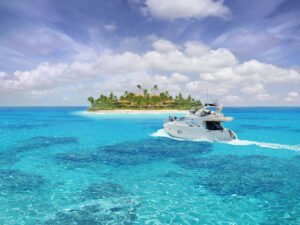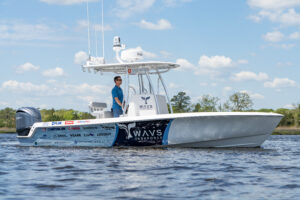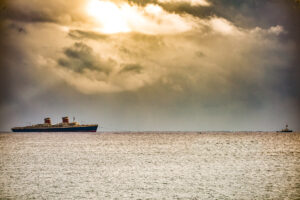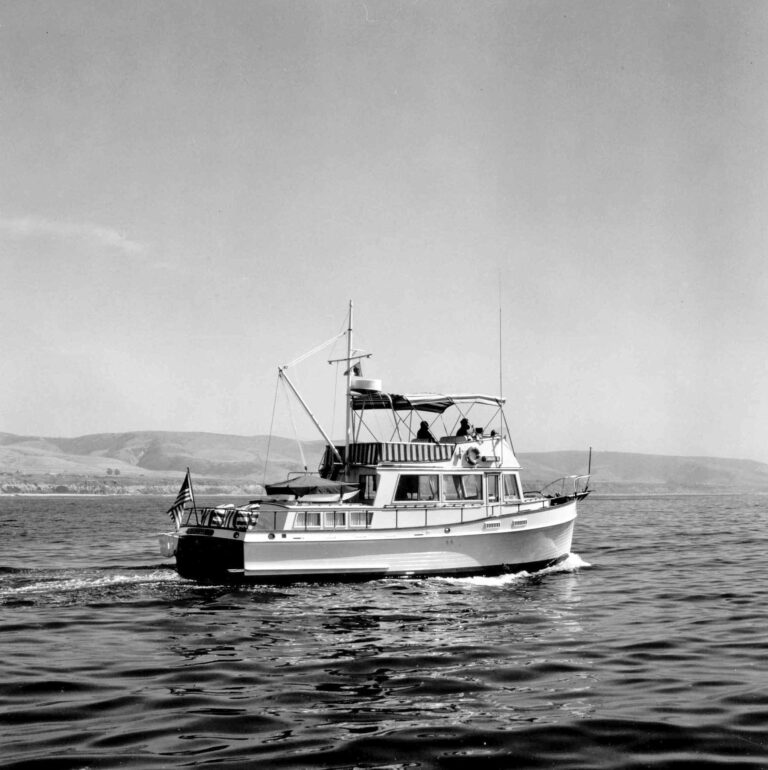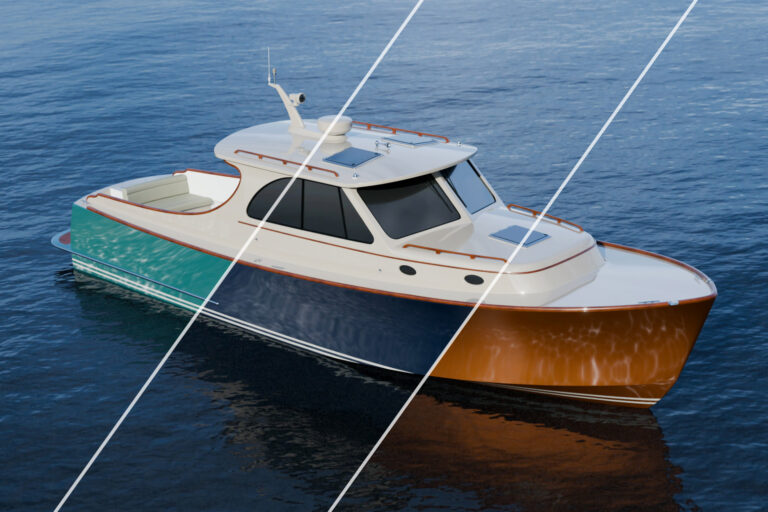Approaching my 77th year of life, I’ve wanted to sail to Baltimore and back from my home port at the Seaford Yacht Club off the York River before retiring from lengthy cruising. I’ve done a lot of single-handed sailing at the bottom of Chesapeake Bay during the past decade and it has often prompted me to look northward and envision cruising a grand loop that would include Annapolis, the Bay Bridge, Baltimore, the Chester River and Kent Narrows, and on to St. Michaels and Oxford.

In case we didn’t get sufficient winds, the explicit challenge was whether considering my age, the age of my 31-foot sloop Caper II (25 years) and its weak 13-hp diesel we could manage the 165-nautical mile push to Baltimore.
About three years ago we got too much wind when my brother-in-law, Carl, and I attempted this direct transit to Baltimore. We were stymied for three days straight by such a strong northeast flow right on the nose, with incessant pounding into 3-to 4-foot waves, that we conceded defeat and turned back south to run with the wind.
Well, the persistent sailor eventually will succeed. Once again, I teamed up with my brother-in-law. Carl is an ex-Marine, and I’m from 17th-century whaling stock out of Southampton on New York’s Long Island. You don’t stop until you secure the beachhead or land the whale. We made Baltimore in five days with light winds and a lot of motoring (Caper is not equipped for night sailing). And we completed our so-called “grand loop” in 11 days, covering close to 400 nautical miles. For us, there were both trials and triumphs during what I consider a life event in 2010.
A good first leg
We made good progress sailing toward our goal on the first three days. Although we hoped to go directly north with the usually reliable southwesterlies, we took advantage of strong northwesterlies (15-20 mph) and made a five-hour crossing of the Bay (36 nautical miles) to the Occohannock River for the first night’s anchorage. We dropped the hook just south of G-13 and had a perfectly sheltered, quiet evening with a magnificent display of starry constellations.
The next day we were counting on NOAA’s forecasted northeast winds as we headed northwest back across the Bay to Point Lookout on the north side of the Potomac River. For an hour or so we had a strengthening northeast flow, but by midmorning the winds shifted to the north and dropped. For the next six hours, we engaged the diesel. Fortunately the temperature was pleasantly in the 70s, and we arrived at the Point Lookout State Park basin in midafternoon in time for a delightful swim across the small lagoon to a pristine beach opposite the state park docks. Our stay that evening was idyllic; our boat was the only one anchored there, perfectly sheltered in calm waters, with bird calls in abundance, schools of fish stirring the water’s surface, cormorants diving and a bald eagle nesting just 50 yards away.

The next day we were back to some serious sailing. As we rounded Point Lookout and headed due north we picked up a strong southeasterly-by-south flow that pushed us rapidly up the western shore toward the Patuxent River. The most dynamic sailing segment occurred as we rounded Cedar Point (off the Naval Air Station). We hit a tidal race with surging waves just off the point, which made for some heavy heeling and bucking over wave crests. With strengthening south-southeasterlies, we roared into the Patuxent River and made straight for Solomons Island, averaging 6 to 7 knots. We had made reservations for a slip with the Solomons Island Yacht Club (one of the oldest clubs on the Bay, dating from 1937), providing us with access to the club, its bath facilities and proximity to a fine fish restaurant on a pier just across the street. All told, we had three terrific days toward Baltimore.
Midday doldrums
We only got a few hours of good sailing at the beginning and end of the next two days. It became ghastly hot, with windless waters that resulted in five- and six-hour motoring sessions in order to reach Baltimore in the maximum five days we had allotted. At Annapolis, the outboard on our dinghy refused to start, so we had to be towed by kindly “cruiser” neighbors from our mooring on the Spa River into Ego Alley at the downtown docks. That evening we had a beautiful pink sunset with an impressive silhouette of the state Capitol dome and church steeples of historic Annapolis, followed the next morning by an equally impressive colorful sunrise capturing the numerous yachts at rest in the harbor.
The sail out of Annapolis the next morning on the Severn River past Greenbury Point was a gem. We tooled along on a nice westerly flow to the middle of the Bay just below the expansive Bay Bridge and then, as the winds once again lightened, motored due north, taking the left span of the bridge, away from the main channel where a large freighter also pushed toward Baltimore. We had a spectacular view as we passed under the twin spans.
We made the final 13 miles on the Patapsco into the Baltimore Inner Harbor about 2:30 p.m. and registered at the Baltimore City Docks for two nights. We were surprised to have these public docks pretty much to ourselves. The urban skyline was quite intimidating, with its towering skyscrapers. We were very much aware of the constant hum of the city and the overwhelming brightness of the city lights at night. However, this type of “urban” cruising was a necessary part of reaching this more northern part of Chesapeake Bay.

We had accomplished our goal, traveling 173 nautical miles in 36 hours and 42 minutes, averaging just over seven hours per day under way. Not bad for two guys in their mid-70s.
New places on the Eastern Shore
On this seventh day out, we faced another long six hours of motoring, with light winds and temps in the high 90s. From the Patapsco River, we cut southeast across the Bay into the Chester River, and then northeast up into the Corsica River to a very beautiful anchorage in Tilgham’s Cove. We immediately took a refreshing swim in the Corsica, which cooled us a bit. We welcomed a beautiful, quiet evening with wine-and-cheese refreshment.
Our run the next day from the Corsica River to St. Michaels was highlighted by the brand-new experience of cutting through Kent Narrows. We motored southwest back down the Chester River and located the north-to-south channel entrance into Kent Narrows. Upon arriving at the drawbridge, we got a quick opening and had first passage through because the right of way went to the south-flowing tidal current. It is a very narrow opening, allowing only for a single line of boats at one time.
A better sailing day
Not long after clearing the bridge and the narrow channel into Prospect Bay, we were once again able to resume sailing down the Eastern Shore on solid 10- to 15-mph southwesterlies. With one tack, we were soon at the channel to St. Michaels. After reprovisioning food and ice, we stopped briefly at the Baltimore Maritime Museum to see the recently restored “bug eye” skipjack and then motored back to the Miles River Yacht Club on Long Haul Creek, anchoring a bit off the club docks. Then the squall hit as a cold front moved in with numerous thunderstorms, big lightning bolts and wind gusts to 25 to 30 mph. For a time we lost sight of the shoreline, but Caper II enjoyed a good washing, and the dinghy stayed tied down on the forward deck. That was the only rainstorm of the entire cruise.
More narrows navigation
The next day on our St. Michaels-to-Oxford run, at the bottom of Eastern Bay, we made the narrow passage past Poplar Island and into Knapps Narrows at Tilgham Island. Again, we got a prompt lift by the bridgemaster on the single-span draw so we could motor directly through without any delay. But then we faced more windless waters on the Choptank River.
At Oxford, we took advantage of the three-hour docking limit at the public pier adjacent to the Tred Avon Ferry dock. This location enabled us to take advantage of shower facilities at the Tred Avon Yacht Club, followed by some fantastic homemade rum-raisin ice cream. We then savored a delicious fish dinner at a restaurant overlooking the Town Creek. For the night, we moved the boat to the mooring area north of the public docks, which gave us a little more exposure to cooler evening breezes.
The final run to home port
The next day, our 10th, we departed at 6 a.m. for the long run back to Point Lookout on the Potomac River. We did not put up the sails, as the windless morning hours continued to be flat to the Patuxent River. When the wind finally picked up, with a strong southerly flow right on the nose – 18 to 22 mph, with higher gusts – we were once again fighting 4- to 6-foot waves that dropped Caper into troughs with a thud. After four hours of pounding, we were grateful to be once again in the safe haven of the Point Lookout boat basin and enjoyed a refreshing swim.
The final day of our cruise progressed rapidly. We weighed anchor at 7 a.m. and had a perfect two-hour-plus sail on moderate westerlies across the Potomac’s entrance, some 12 miles and a bit beyond Smith’s Point. Then we motored to Windmill Point on the Rappahannock, followed by freshening westerlies off Stingray Point, enabling us to sail past Gwynn’s Island and go a good ways toward Wolf Trap light. By that time we were only three to four hours from the Seaford Yacht Club, so we agreed to go for it. We arrived at our slip right at 7 p.m., completing our “grand” cruise in two days less time than anticipated and surviving the very longest cruise day I’ve ever done – some 62 nautical miles in 12 hours. We were so glad to get out of that heat wave and back to an air-conditioned house that night.
When we returned the next day to clean up Caper II, we knew our decision to come back early was a good one. If we had returned on that 12th day, we would have had another battle with strong southwesterlies right on the nose.
This article originally appeared in the Mid-Atlantic Home Waters section of the December 2010 issue.


